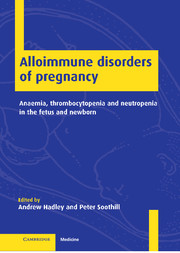 Alloimmune Disorders of Pregnancy
Alloimmune Disorders of Pregnancy Book contents
- Frontmatter
- Contents
- List of contributors
- Preface
- Foreword
- List of abbreviations
- 1 Pathophysiology of the alloimmune cytopenias
- 2 Blood group antibodies in haemolytic disease of the fetus and newborn
- 3 Basis and practice of screening for haemolytic disease of the fetus and newborn
- 4 Epidemiology and screening for alloimmune thrombocytopenia
- 5 Principles of antibody-mediated immune suppression and the prevention of maternal RhD alloimmunization
- 6 The clinical application of anti-D prophylaxis
- 7 Fetal genotyping
- 8 Laboratory assays to determine the severity of haemolytic disease of the fetus and newborn
- 9 Assessing the severity of haemolytic disease of the fetus and newborn: clinical aspects
- 10 Antenatal therapy for haemolytic disease of the fetus and newborn
- 11 Neonatal therapy for haemolytic disease of the newborn
- 12 The diagnosis of alloimmune thrombocytopenia
- 13 The immunological diagnosis of alloimmune neutropenia
- 14 Fetal and neonatal treatment of alloimmune thrombocytopenia
- Index
14 - Fetal and neonatal treatment of alloimmune thrombocytopenia
Published online by Cambridge University Press: 26 October 2009
- Frontmatter
- Contents
- List of contributors
- Preface
- Foreword
- List of abbreviations
- 1 Pathophysiology of the alloimmune cytopenias
- 2 Blood group antibodies in haemolytic disease of the fetus and newborn
- 3 Basis and practice of screening for haemolytic disease of the fetus and newborn
- 4 Epidemiology and screening for alloimmune thrombocytopenia
- 5 Principles of antibody-mediated immune suppression and the prevention of maternal RhD alloimmunization
- 6 The clinical application of anti-D prophylaxis
- 7 Fetal genotyping
- 8 Laboratory assays to determine the severity of haemolytic disease of the fetus and newborn
- 9 Assessing the severity of haemolytic disease of the fetus and newborn: clinical aspects
- 10 Antenatal therapy for haemolytic disease of the fetus and newborn
- 11 Neonatal therapy for haemolytic disease of the newborn
- 12 The diagnosis of alloimmune thrombocytopenia
- 13 The immunological diagnosis of alloimmune neutropenia
- 14 Fetal and neonatal treatment of alloimmune thrombocytopenia
- Index
Summary
Alloimmune thrombocytopenia is the commonest cause of neonatal thrombocytopenia, occurring in one in 1000–2000 live births; this is equivalent to 400–800 cases per year in the UK. The pathogenesis of alloimmune thrombocytopenia is similar to HDFN (Chapter 1):
• The mother is negative for a platelet alloantigen which the fetus has inherited from the father, and maternal alloimmunization occurs in a proportion of women who may have a genetic predisposition to become immunized (Section 1.3.3).
• Placental transfer of IgG antibodies may result in moderate to severe thrombocytopenia as early as 16 weeks’ gestation.
• The most clinically significant incompatibility is for HPA-1a, the frequency of this antigen being 97.5% in Caucasians (Section 12.3).
• HPA-1a alloimmunization is HLA class II restricted; there is a strong association with HLA-DRw52a (HLA-DR3*0101), which is present in one in three of Caucasian women. Although the negative predictive value of the absence of HLA-DR3*0101 for HPA-1a alloimmunization in HPA-1a-negative women is >99%, the positive predictive value of its presence for alloimmunization has been estimated to be only 35%, and not all alloimmunized mothers will have babies with thrombocytopenia (Section 4.2).
• The antibody titre and isotype have not been shown to correlate consistently with the development or severity of disease (Section 12.4.4.2).
- Type
- Chapter
- Information
- Alloimmune Disorders of PregnancyAnaemia, Thrombocytopenia and Neutropenia in the Fetus and Newborn, pp. 253 - 278Publisher: Cambridge University PressPrint publication year: 2001
